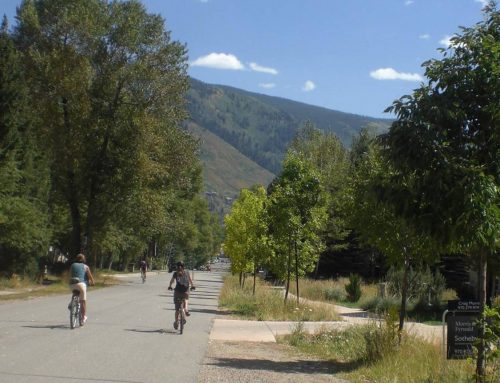Because I disagreed with the book premise, I read with great interest The New Geography of Jobs by Enrico Moretti. Moretti pronounces that innovation hubs are location-specific, need to be located in largish cities, and that your economy is majorly screwed if it is not an innovation hub. The premise is telling me that our successful business which is headquartered in a thriving small town is doomed.
Firstly, I discount much of what economists say because their major premise is that the local and global economic machine must physically grow. Contrast this with the alternate facts provided by numerous thought leaders (Limits to Growth – the 30-Year Update , Lean Logic , The One Straw Revolution, The Transition Towns movement , the IPCC , etc, etc.) who point out that exponential economic growth is unsustainable on a finite planet, that what is needed is a sustainable transition to better quality instead of more quantity, and that we must prepare for disruptions of that global growth model.
That being said, what can be learned from Moretti, and what can be done about it?
- Moretti: “In innovation, a company’s success depends on more than just the quality of its workers – it also depends on the entire ecosystem that surrounds it”. “A growing body of research suggests that cities are not just a collection of individuals but complex, interrelated environments that foster the generation of new ideas and new ways of doing business.” “Your salary depends more on where you live than on your resume.”
I think these statements are largely true, but that businesses that are not physically located in an innovation hub can overcome them by establishing an active and vital network with the innovators of its industry, and those innovators on the fringes of the industry. We at Crabtree Group have done this through a very active* participation in the Congress for the New Urbanism (CNU) reading and applying both classic textbooks and the writings of modern innovators, striving in each project to apply basic principles of design while developing a new innovation that tactically improves on the basic principles, eschewing the conventional proprietary competitive games, and sticking to our principles by emphasizing legacy over profit. *Regular Congress and workshop participation, helping found the Rainwater-in-Context Initiative and Rainwater listserve helping found the Lean Urbanism Initiative and Transect Codes Council, managing Adaptive Urbanism and CNU Climate Change listserves, winning a CNU Charter Award, co-authoring a book with a CNU colleague, writing articles for Stormwater Magazine , presenting and keynoting at Stormcon, writing a SmartCode Regional Watersheds module and editing several others, founding a local Complete Streets committee, etc..
We also engage in dozens of design charrettes annually in small towns, large cities, and internationally. These charrettes are gatherings of the top thinkers and doers of the profession and are always innovative learning experiences that form the leading edge of the profession.
A takeaway is that we should be better at encouraging more staff participation in congresses, listserves, competitions, informal professional discussions, workshops that will foster the growth of our ecosystem; and that we should work harder to foster local innovation networks through local workshops or working to gather more locals into the fold. In economists terms – thicken our markets.
- “My research, based on an analysis of 11 million American workers in 320 metropolitan areas, shows that for each new high-tech job in a metropolitan area, five additional local jobs are created outside of high tech in the long run.” “Attracting a scientist or a software engineer to a city triggers a multiplier effect, increasing employment and salaries for those who provide local services.” “While the vast majority of jobs are in the non-traded sector, this sector is not the driver of our prosperity. Instead, our prosperity mainly depends on the traded sector.”
True, and I would bet that the same holds true for our staff being a tremendous boost to the local jobs market. And our market extends far beyond the local market (making it a “traded” sector), so our salaries are being funded through national and global markets. We should probably make this better known to our local leaders.
- “New technologies tend to favor highly skilled workers, reduce the need for many occupations calling for medium-level skills, and barely affect occupations at the low end of the skill spectrum”. “Jobs in innovation are often found in unexpected places. What they all have in common is that they make intensive use of human capital and human ingenuity.” “What really matters is that American workers produce goods or services that are innovative and unique and not easily reproduced.”
Thirty years ago a typical engineering and planning office had a high percentage of clerks and draft persons. Computer software has largely obviated the need for these middle-level personnel. The career track of a young engineering professional should include being at the cutting edge of the new technologies such as Civil 3D, GIS, graphics software, and similar skillsets. Meanwhile, artistic skills in graphics arts – even hand drafting, are still in demand. Other key skills that are unlikely to be automated are creative design and leadership in project management.
- “In most innovative industries, the main production costs are the fixed costs of research and development.”
Developing an innovation can be very labor intensive, and we should keep better records (only some are posted on our website) of our innovations so that they can be more easily replicated on future projects. This will help us (and others) to continually improve our results at less cost, which can then help to finance new innovations. Some of these innovations are: the “black box” insular block infrastructure (Haiti), Rainwater Harvesting Street (Mecca), Tree Zippers, Tree Pockets (Phoenix), Oasis Sustainable Water for Neighborhoods (Mecca), Water Balance Dashboard (Tehachapi), Arroyo Transect (El Paso), Salon des Refuses Rainwater solutions for TNDs (Houston), Rapid Infrastructure Cost Estimating spreadsheets (Salt Lake City), use of the SmartCode in daily engineering practice, hillside TND grading protocols (Tehachapi and Philippines), development code errors evaluation procedure (Tehachapi), Watershed Restoration (Ventura), Lean Infrastructure, Rainwater-in-Context.
- “Italians are giving up career opportunities and higher salaries to be close to their parents and friends. At the national level, this immobility worsens the unemployment problem and lowers overall job and income growth.”
Yet, those areas of southern Italy are some of the most-loved places on the globe, with some of the happiest populations. This is where the economist’s single metric of “economic growth” shows its soft underbelly. Place-based quality of life can be more important than income growth to many people. And smaller towns can provide more opportunities to influence politics, to have shorter commutes, to be closer to nature and agriculture.
So sure, innovation hubs like Silicon Valley are great for America’s economy but some of the principles that make The Big Innovation Hubs thrive can be applied throughout the US, especially when integrated with historically successful place-based strategies.



